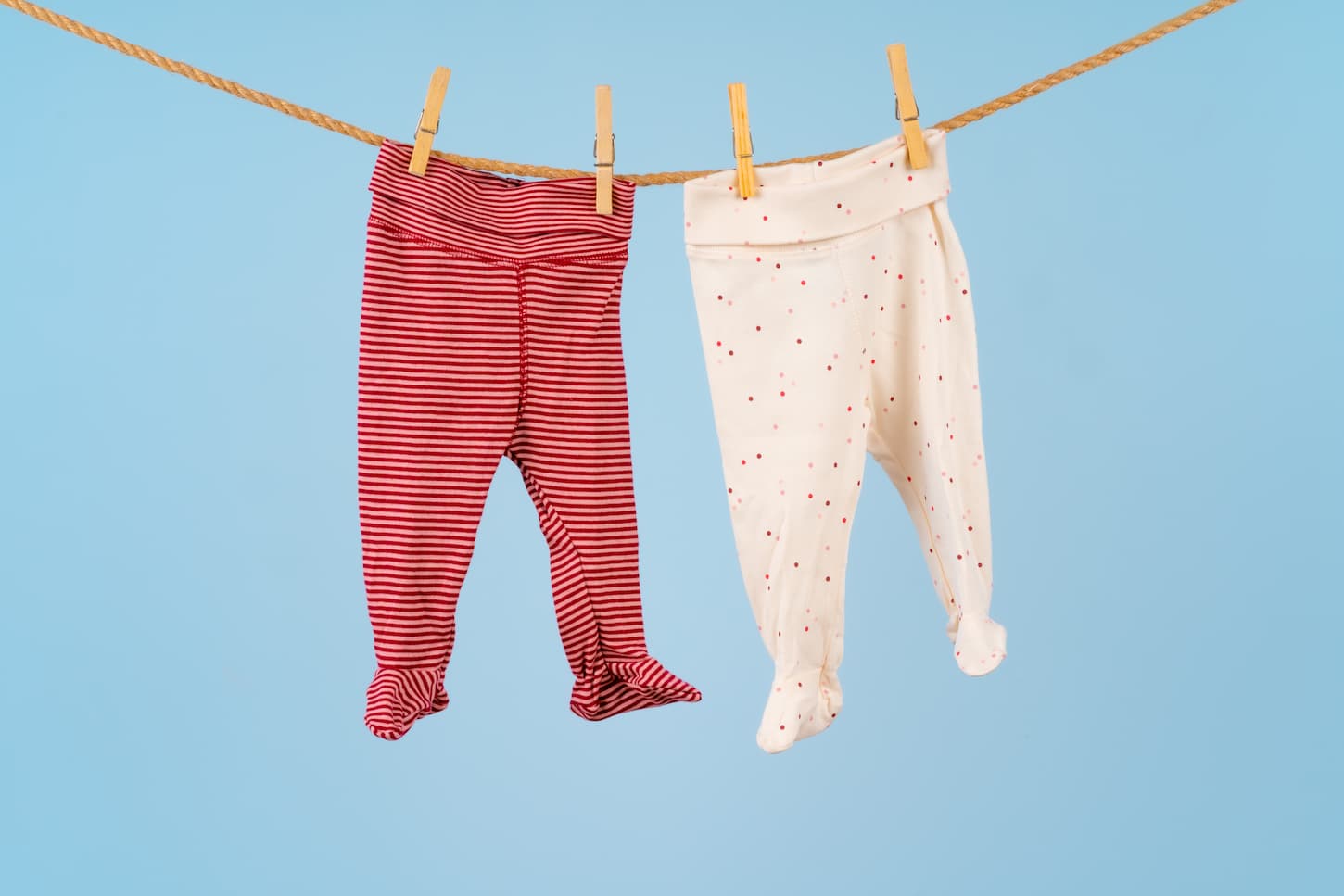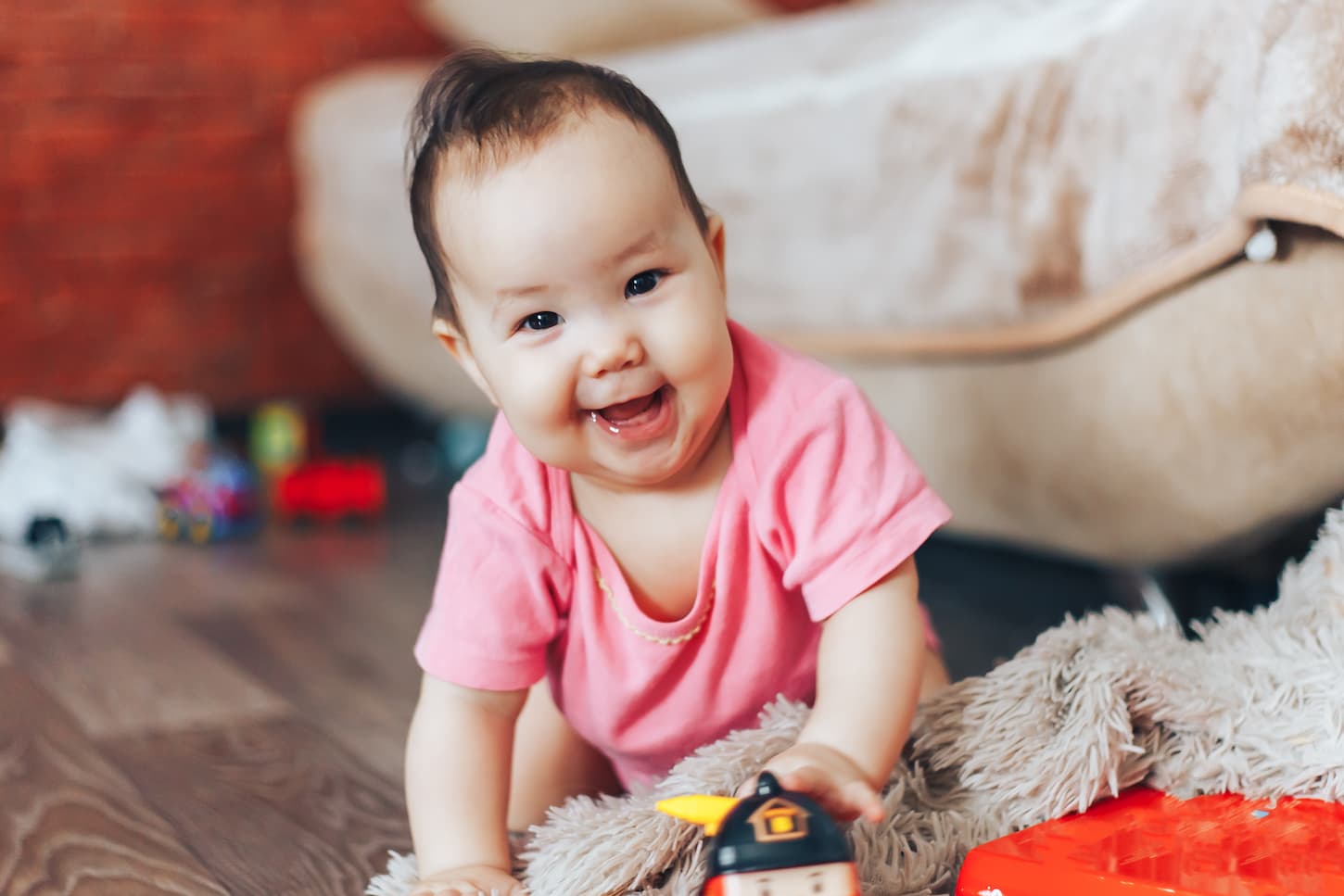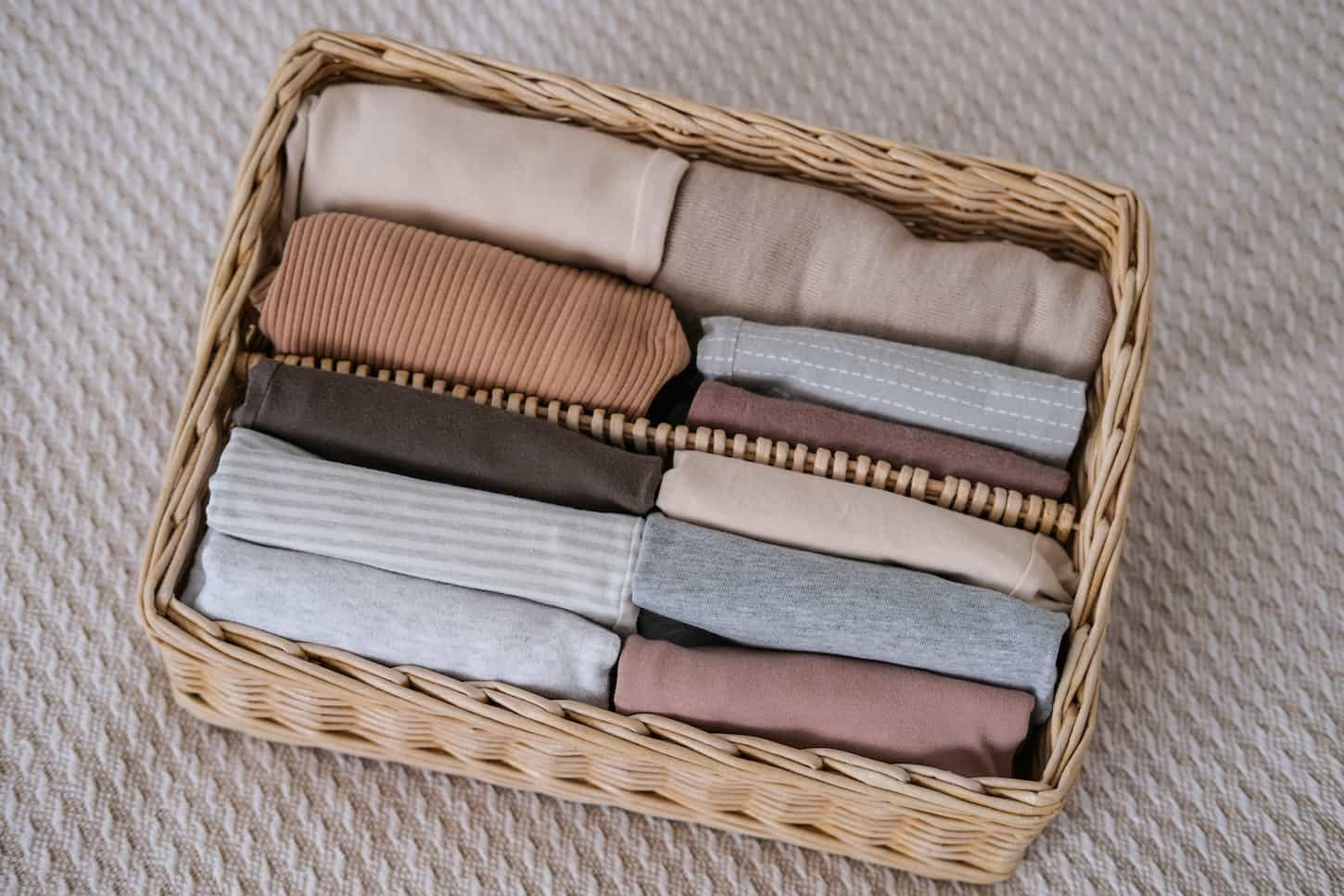If you look at the labels on children’s clothing, you’ll often find that they’re made from polyester. This is a durable, inexpensive fabric that comes in a range of bright colors and soft, fluffy textures. But just how safe is polyester for your baby’s skin?
Polyester clothes and pajamas are safe, but aren’t as breathable or absorbent as other materials, like cotton. There’s also less transparency about the chemicals used to produce some polyester clothing. Polyester clothes may be less desirable than other organic options.
If you want to know more about polyester clothing and whether it’s safe for babies, you can find out everything you know in this helpful guide. This way, you can make an informed decision when it comes to choosing polyester clothing for your baby.

What is Polyester?
Polyester is a synthetic fiber made from a mix of acids and alcohols and it’s derived from petroleum. So ultimately, it’s a type of (very modified) plastic. It’s an appealing material because it’s inexpensive, durable, soft, and stain resistant. And on top of this, it’s flame and fire-resistant too.
However, raw polyester fibers aren’t “naturally” fire-resistant. They have to be treated with chemicals during the production process. This production process uses lots of hazardous and carcinogenic substances. However, the finished product is considered to be safe.
You can find plant-based and recycled polyester products available on the market. But these are quite rare, more expensive, and less durable than standard polyester. And on top of this, they still go through a harsh chemical manufacturing process.
Why is Polyester Used in Babies’ Clothes?
During the 1950s, many children were admitted to hospitals due to burns from their pajamas catching fire. Cases were so common that laws were written that required children’s clothing manufacturers to make fire-resistant clothes. This is when polyester became a popular material for children’s clothing.
But manufacturers didn’t use polyester right away. First, they tried adding all kinds of nasty chemicals to the clothes to make them fire-resistant. But these chemicals turned out to be carcinogenic and were promptly banned. And this is when manufacturers started using flame-resistant polyester for making children’s clothes and pajamas.
Are Polyester Clothes Safe for Babies?
According to manufacturers, polyester is safe for babies. But manufacturers have made mistakes in the past regarding harmful chemicals in clothing. And they’re not always transparent about the chemicals they’re using in production. Thus, the safety of polyester clothing for babies is questionable.
It’s important that your baby’s clothes don’t contain any nasty chemicals. This is because the skin is the largest organ in the body and it’s very absorbent. So, if there are chemicals in the clothes, more than likely, they’ll enter your baby’s body. And babies are very sensitive during early development. So, it’s not a good idea to expose them to toxic chemicals.
On top of this, not all babies tolerate polyester clothing. It can bring some sensitive-skinned babies out in an itchy rash. So if your baby has sensitive skin or any kind of skin condition, you should definitely choose natural fabrics instead of polyester.

Why is Polyester Bad?
Even though polyester is a fire retardant, often, it’s still treated with chemical protection. And it’s thought that the harsh chemicals used in polyester production get caught up in the fibers. As well to this, it isn’t breathable or absorbent so it’s not good for your baby’s skin.
The chemicals and dyes used in polyester production and flame retardants are pretty potent. Some of them are known carcinogens and hormone and immune disruptors. But it’s hard to keep on top of the exact chemicals that are used in polyester clothing because manufacturers are constantly changing their chemical compounds.
Additionally, they refuse to disclose exactly what they’re using on their clothes. So, without this transparency, it’s hard to make a clear judgment about the safety of polyester clothing for babies.
As well as this, polyester isn’t breathable, and it doesn’t absorb sweat away from the skin. This means that toxins from sweat will linger on your baby’s skin, potentially causing rashes.
And because of the chemicals used in its production, polyester isn’t very environmentally friendly. As well as this, polyester garments release tiny beads of plastic when they’re being washed. Thus, polyester is largely responsible for the huge amounts of micro-plastics that are polluting our oceans.
Overall, natural fibers are better for your baby’s health and skin than polyester. And they’re also better for the environment.
Can Babies Sleep in Polyester?
Babies shouldn’t sleep in polyester clothes or pajamas. This is because they’re not breathable and they can interfere with the way your baby regulates its body temperature. And ultimately, this may leave your baby more at risk of sudden infant death syndrome (SIDS).
Because polyester is effectively plastic, it’s not very breathable and it can cause your baby to overheat. And if babies overheat when they’re sleeping, they’ll sweat. And with polyester, the sweat can’t escape so it’s easy for your baby to get a chill.
As well as this, overheating will also disturb your baby’s sleep and can cause a heat rash. More alarmingly, overheating is thought to be related to sudden infant death syndrome (SIDS). Most cases happen in winter when parents layer their babies in clothing to keep them warm.
If your baby does sleep in polyester clothing, then be wary about using layers on top or underneath. And as well as this, you should make sure that the room temperature is a bit on the cool side to prevent your baby from overheating. The ideal temperature for a baby’s bedroom is between 68- and 72- degrees Fahrenheit.
Pajama Fire Safety and Polyester
You may want to use polyester nightwear for your baby because it’s less of a fire risk. However, it’s good to know that they’re not the only option for keeping your baby safe from fire and burns.
You may have noticed that baby pajamas are always tight and snug fitting. This is because tight-fitting clothes are less likely to catch on an open flame or heat source.
As well as this, when the clothing sits close to your baby’s skin, there’s very little oxygen in between the skin and clothes. And fire needs oxygen to keep burning, thus, without a layer of oxygen, it’s less likely that the clothes will set alight.
So even when pajamas are made from natural fibers, they’re still considered to be fire resistant if they’re tight-fitting.

Can Baby Clothes Have Polyester?
It’s quite common to find polyester in babies’ clothes. And even when clothes are labeled as natural, they may still contain a small percentage of polyester. This is because polyester is often blended with natural fibers.
Manufacturers will often use polyester blends because the addition of polyester will make natural fibers a bit more durable, stain-resistant, and long-lasting. And they may also use polyester to “bulk up” natural fibers to increase their profit margin.
If you want to know if baby clothes contain polyester, then have a look at the label. This will tell you exactly how much polyester is in the clothing. Don’t assume that something labeled as natural doesn’t contain polyester.
Are Polyester Toys and Blankets Safe for Babies?
When it comes to buying baby toys, especially soft ones, it’s hard to avoid polyester these days. But because the safety of polyester is questionable, you should avoid them if you can. And because polyester isn’t breathable, you should avoid using it for your baby’s bedding.
Polyester sheets and blankets aren’t breathable so they can cause your baby to overheat in the same way that polyester pajamas do. So, it’s better to use natural fabrics for your baby’s bedding instead of polyester.
You should also avoid giving babies polyester and plastic/PVC toys. This is because babies love to put toys in their mouths. So, you don’t want them ingesting any plastic particles or chemicals such as Phthalates and BPA’s.
Instead, you should give your baby wooden toys designed for babies which aren’t coated with anything toxic, and with a soft smooth finish. Or choose stuffed toys that are made from natural or organic fabrics and fillers rather than polyester ones.
And natural rubber or food-grade silicone toys are a good alternative to plastic and polyester toys for teething babies. If you’d like some ideas to get you started, here are a few I’ve found on Amazon. At the time of publishing this article, all of these are very reasonably priced. But prices do change on Amazon regularly, so make sure you shop for sales.
Organic bedding and sheets:
- 100% Organic Turkish Cotton – Pack of 2-28 X 52 for Standard Crib and Toddler Mattresses – Silky Soft and Hypoallergenic (on Amazon)
- Kyte BABY Soft Crib Sheets Made from Bamboo Rayon Material (Oat) on Amazon
Organic toys for babies:
- 2pc Set Wooden Teether Rattle Toys Beech Wood Teething Ring Montessori Bird Shape Grasping Toddler Toys on Amazon
- Bears for Humanity Organic Sherpa Bear Plush Toy, White, 10 Inch
- Itzy Ritzy Silicone Baby Teether – BPA-Free Infant Teether with Easy-to-Hold Design and Textured Back Side to Massage and Soothe Sore, Swollen Gums, Llama
What Kind of Clothes Are Better for Babies?
Your baby’s skin is very absorbent so you should choose natural, breathable materials such as cotton and bamboo. These are much more comfortable for babies. And organically produced natural materials are best because they aren’t exposed to chemicals in the production process.
So, with this in mind, let’s take a look at the best natural materials for a baby’s clothing.
- Cotton – This has always been the choice material for babies because it’s durable, breathable, and easy to care for. It doesn’t have any safety concerns and it’s been tried and tested by endless generations.
- Bamboo – This is a great material for babies because it’s thermo-regulating. This means that it helps your baby regulate body temperature, unlike polyester which does the opposite. Bamboo is naturally hypoallergenic so it’s great for sensitive babies. And as well as this, it’s absorbent so keeps moisture away from your baby’s skin. Bamboo is super soft and comfortable, and it’s usually produced sustainably.
- Jersey Knit – This is a type of cotton so it’s breathable, durable, and comfortable on your baby’s skin. Another good thing about Jersey knit is that it’s soft and stretchable, and it doesn’t pill like cotton.
- Hemp – Although hemp has a reputation for being a bit coarse, after a few washes it becomes softer. As well as this, hemp is highly breathable and has natural antibacterial and antimicrobial properties. Hemp is such a strong plant that it doesn’t need any additives or pesticides to help it grow, making it one of the most environmentally friendly materials around.
- Linen – This is a natural fabric that’s breathable and absorbent making a good material for summer clothes. But sometimes linen can be quite coarse so you should choose thin linen garments for small babies.

Going Organic
Many natural materials, such as cotton, are still treated with chemical pesticides during the growing and manufacturing process. So, to eliminate the risk of your baby being exposed to chemicals, you should buy clothes made from organic materials.
When you’re looking for organic clothes for your baby, you should look out for clothes with a GOTS label. This is the certified global organic textile standard. So, you can be sure that no chemicals were used in growing or production.
Another label to look out for is OEKO-TEX Standard 100 which screens for about 100 harmful substances. These clothes aren’t necessarily organic, but they do screen for the most harmful chemicals.
Now, if you’d like to shop for some organic baby clothes, here are a few great options I’ve found on Amazon. That way, you’ve got the hard part (of research) out of the way – and you can focus on the fun part – picking out colors and designs.
Full body suits with and without feet:
- Cotton Zip-front sleeper pajamas – O2 BABY brand on Amazon
- Bamboo and spandex footie pajamas – HAPIU brand on Amazon
- Moon and Back by Hanna Andersson Baby/Toddler Boys’ and Girls’ One-Piece Organic Cotton Footless Pajamas (on Amazon)
Onesies:
Materials You Should Avoid
You should avoid dressing your baby in other synthetic fabrics such as nylon and acrylic. These fabrics are like polyester in the sense that they don’t breathe or absorb sweat. And even though wool is a natural material, you should avoid dressing your baby in woolen clothes.
Wool is very breathable and has antimicrobial properties, but overall, it’s coarse and can be quite scratchy on a baby’s skin. If you want to dress your baby in woolen clothes, make sure you use a layer underneath, so it doesn’t irritate.
With wool, it’s also important to keep an eye on the local weather. If you live in a warmer place, then wool-based clothes shouldn’t be your go-to choice when it’s hot outside. I mean, would you want to wear wool in the summer?
If you wouldn’t wear wool, the general thought is to avoid putting it on your child.
On the flip side, if it’s cold outside and you would wear wool? It can be a great choice for your baby. But think about putting on an undershirt – so that your baby doesn’t get all scratchy from the wool clothes.
Conclusion
Polyester is used to produce lots of baby items, including clothes and pajamas, and is generally promoted as safe – though its safety is questionable.
The bottom line is, that you should avoid dressing your baby in too many polyester clothes, especially for sleeping. This is because polyester isn’t breathable and doesn’t absorb sweat, which isn’t good for your baby’s skin.
My children liked sleeping in a polyester-based sleep sack, but only if the cotton one wasn’t available. And even then, they liked having a breathable cotton onesie on underneath the polyester.
So overall, if you’re researching the best clothes for babies, I’d recommend you stick to cotton and natural fibers when and where you can. Then, make sure you’ve got a handful of cotton onesies for layering when you do pull out the polyester outfit.
Now that you know more about polyester, make sure you read this article on fleece next: Should Babies Sleep in Fleece? What Parents Must Know! That way, your baby will be dressed for any and all seasons.
Resources
Learning about parenting or sleep training techniques is important to learn from various reputable sources. These are the sources used in this article and our research to be more informed as parents.
- “Flame Retardants.” National Institute of Environmental Health Sciences, www.niehs.nih.gov/health/topics/agents/flame_retardants/index.cfm. Accessed 7 Sept. 2021.
- National Research Council (US) Committee on Pesticides in the Diets of Infants and Children. Pesticides in the Diets of Infants and Children. Washington (DC): National Academies Press (US); 1993. Executive Summary. Available from: https://www.ncbi.nlm.nih.gov/books/NBK236271/
- “NIH Alerts Caregivers to Increase in SIDS Risk during Cold Weather.” National Institutes of Health (NIH), 6 Oct. 2015, www.nih.gov/news-events/news-releases/nih-alerts-caregivers-increase-sids-risk-during-cold-weather.
- Rovira J, Domingo JL. Human health risks due to exposure to inorganic and organic chemicals from textiles: A review. Environ Res. 2019 Jan;168:62-69. doi: 10.1016/j.envres.2018.09.027. Epub 2018 Sep 24. PMID: 30278363.